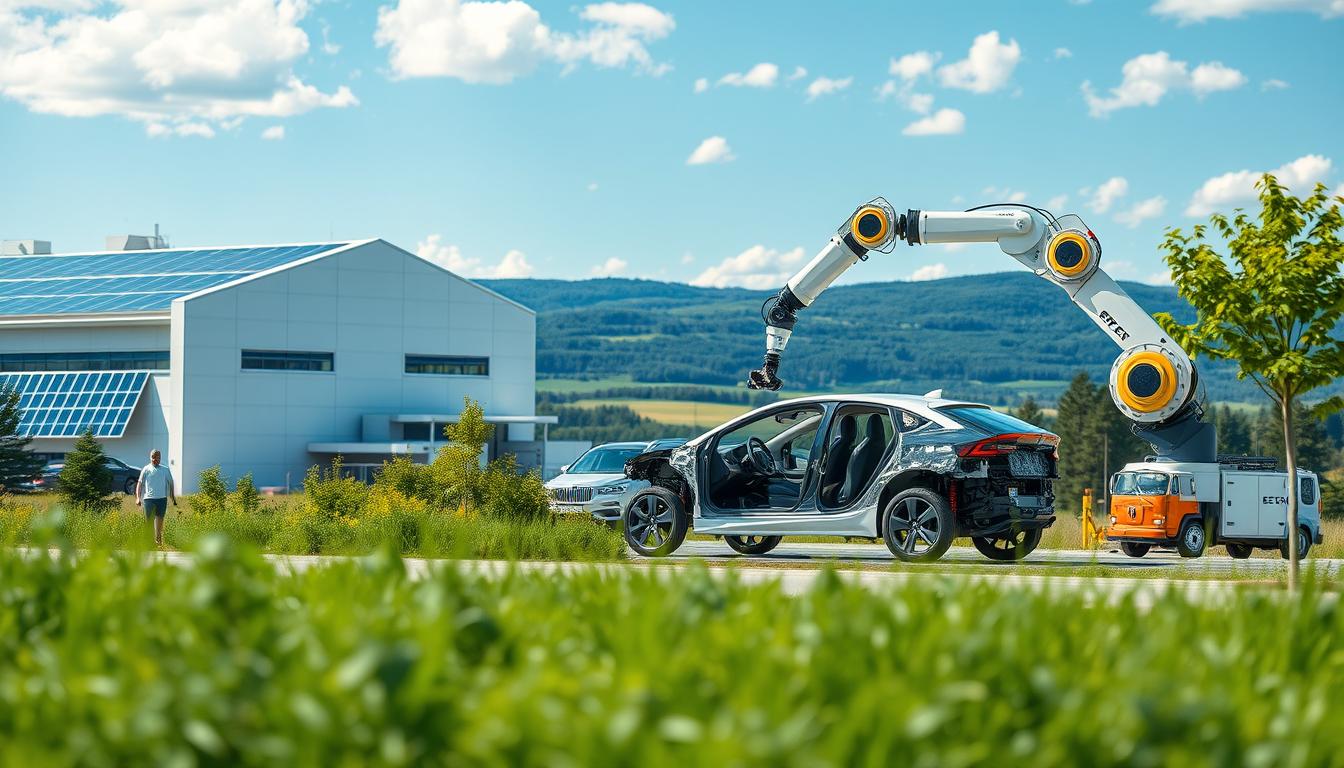The electric vehicles (EVs) are significantly transforming the automotive industry. When the whole world becomes more eco-friendly, the question appears: are EVs green enough?
The concept of sustainable manufacturing is gaining traction towards EVs production. Manufacturers are currently emphasizing on the minimization of their imprint on the environment through the use of green technologies and processes.
The discussion about the ecological effects of EVs in comparison with those of traditional gas-powered vehicles is still going on. The article will also take a closer look at what sustainable manufacturing in the automotive industry entails and whether EVs are really the more environmentally friendly option.
Key Takeaways:
- There is a move towards sustainability in the production of vehicles.
- Electric cars are gaining popularity and one of the greener alternatives.
- EVs are under close scrutiny as to their effect on the environment.
- Manufacturing sustainably is vital in minimizing environmental impact of EVs.
- The automotive industry will be reliant on the use of greener technologies in the future.
The Electric Vehicle Environmental Claims:
With the world facing the climate change problem, Electric Vehicles have come out as a possible greener option. The advertising of EVs tends to focus on the fact that the vehicles have zero tailpipe emissions, which implies a substantial decrease in the environmental impact. But the truth of the matter is more complicated.
Zero Emission Marketing vs. Reality:
At least tailpipe emissions are not made by EVs, but the manufacturing process and production of EV batteries in particular has its footprint. It has been established that mining of raw materials such as lithium and cobalt can have a disastrous effect on the environment. In addition, the electricity source, which is utilized in charging EVs, is an important factor to factor into the overall impact on the environment.
Consumer Perceptions and Market Trends:
Environmental advantages of EVs are a major factor of consumer perception towards EVs. Polls reveal that a significant number of consumers feel that EVs are more environmentally-friendly and this is increasing the demand. Market trends show a significant shift towards EVs, with many manufacturers committing to electrify their lineups. Key factors influencing this trend include:
- Increasing government incentives for EV purchases
- Expanding charging infrastructure
- Growing public awareness of environmental issues
The Environmental footprint of the Automotive Manufacturing:
With the world moving towards a more eco-friendly mode of transportation, the environmental impact of the automotive production process, especially the EVs, is subject to criticism. Electric vehicles are produced in a number of processes starting as far back as extraction of the raw materials, manufacturing and assembling, each process having its own environmental impacts.
EV Battery Manufacturing: The Unseen Price:
Making electric vehicles also has a considerable impact on the total environmental footprint of EV batteries. Production of battery requires extraction and processing of different materials such as lithium, nickel, cobalt which may have negative environmental effects.
Impact of Rare Earth Minerals and Mining:
The rare earth minerals that are widely needed to manufacture EV batteries may cause soil and water contamination and destruction of habitat. As an example, mining of lithium, especially within South America, has been an issue of concern with regards to the use of water and contamination.
Battery Disposing and Recycling Problems:
EV batteries become very difficult to dispose and recycle at the end of their service life. The most important thing is to develop efficient technologies that will reduce the negative effects of battery waste on the environment and reuse valuable materials.
| Material | Environmental Impact | Recyclability |
| Lithium | Water pollution, habitat destruction | Moderate |
| Nickel | Soil pollution, health risks | High |
| Cobalt | Human rights concerns, pollution | Moderate |
Production of Energy Demands:
Another critical aspect of the environmental footprint of the EVs is the energy needed to make them. The majority of manufacturing plants are still using fossil fuels, which cause greenhouse gas emissions. Nevertheless, this situation is likely to change as the carbon footprint of EV production will be reduced as renewable energy sources become more common.

The Question of the Electricity Source:
The power source that charges EVs is a major factor that would affect the general environmental impact. Areas that have a high proportion of renewable energy sources will be able to significantly lower the carbon footprint of EVs as opposed to those that are dependent on fossil fuels.
Full Life Cycle Carbon Analysis:
To have a complete lifecycle carbon analysis of EVs is to analyze the emission generated during production, use, and disposal/recycling. Such an all-encompassing strategy will allow to define which areas should be improved and give a better understanding of the actual environmental benefits of EVs.
Knowing the different steps of EV production, as well as the effects it has on the environment, manufacturers will be able to make the entire green transportation footprint smaller. The environmental advantages of EVs will increase with the inclusion of the technology and the use of renewable energy in the manufacturing process.
Conclusion: Making it through the Future of Green Transportation:
Sustainable Manufacturing practices in the automotive industry will play a key role in minimizing the environmental footprint of cars. EVs are argued to be a more environmentally friendly solution, but when the aspect is explored further, the general environmental impact of EVs depends on multiple factors, such as energy sources and manufacturing processes.
Manufacturers need to use holistic sustainability strategies in order to realize Green Transportation taking into account the whole lifecycle of vehicle. These involve enhancing the battery of EV production, more energy efficiency in manufacturing, and encouraging the use of renewable energy sources.
The policymakers and consumers too are important factors in turning the industry to a more sustainable future. Consumers can contribute to the growth of the environmental footprint of the automotive industry by helping to implement policies that promote the use of green technologies as well as making well-informed decisions on the cars that they buy.
With the industry still in its development, the innovation and investment in Sustainable Manufacturing practices will be needed to reduce environmental footprint of vehicles and to achieve a really green transportation system.
FAQ:
Are electric cars indeed greener cars as compared to regular gas-powered cars?
The carbon footprint of the electric vehicles is lower than the traditional gas-powered cars, yet its overall environmental footprint is also dependent on a number of factors, such as the origin of electricity in the process of charging and the manufacturing process.
What is the environmental cost of EV battery creation?
The manufacturing of EV batteries has a high ecological impact because of the mining of rare earth resources, use of energy, and possible contamination. Nevertheless, Tesla and LG Chem manufacturers are striving to make the battery manufacturing processes environmentally less harmful.
What impact on the environmental benefits of EVs does the electricity source have?
The source of electricity used to charge EVs is of significant influence on the environmental advantages of EVs. The total carbon footprint of EVs would be significantly lower in case the electricity supply is supplied by renewable power sources such as solar power or wind power.
What are some of the issues relating to EV battery disposal and recycling?
The recycling and disposal of EV batteries are not that simple as the battery design is complicated and can lead to pollution. Such firms as Umicore and Redwood Materials are working on closed-loop recycling to overcome these issues.
Is it possible to enhance the environmental sustainability of EVs through the application of sustainable manufacturing practices?
Yes, the environmental sustainability of EVs can be considerably positive with the help of sustainable manufacturing practices. Some of the practices that manufacturers can engage in to reduce their environmental footprint include the use of renewable energy, minimization of waste and recycling programs.
What is the place of rare earth minerals in EV manufacturing?
Lithium, cobalt, and nickel are the rare earth minerals which are an essential part of EV batteries. Nevertheless, transportation and refinement of these resources may pose tremendous environmental and social consequences and thus should be responsibly sourced and recycled.


